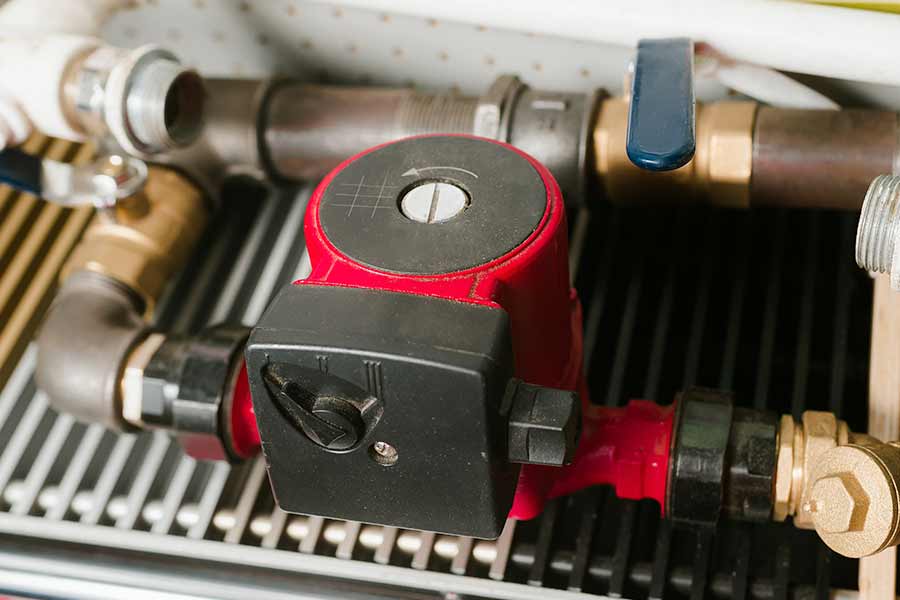Your circulation pump plays a crucial role in the functioning of your central heating system. If it develops a fault, it’s likely to cause problems with your hot water and heating.
In this article, we explain what the circulating pump does and how to recognise problems. We’ll then walk you through our circulation pump troubleshooting checklist.
What is a circulating pump?
A circulating pump is a water pump that moves hot water around your heating system. The water travels from your boiler through to the pipes that feed your radiators, towel rails, and hot water cylinder. The water then flows back to the boiler to maintain a constant flow of heated water around your home.
Central heating circulating pumps are usually located inside or near your boiler, or in your airing cupboard next to your hot water cylinder.
If your pump is inside your boiler, follow our guide to help avoid a boiler breakdown in future and keep your circulating pump in tip top condition.
Circulating pump not working?
There are a few tell-tale signs that indicate your circulator pump system isn’t working correctly. You may notice:
- The water flow pipe isn’t hot despite the pump running
- A water leak coming from the pump
- The pump is making unusual noises
- The pump casing feels hot
- Some or all of your radiators aren’t heating up
- You have no hot water
These can be caused by problems such as blockages or an airlock in the system which can be fixed. So, before rushing into replacing the pump, follow our checklist below to diagnose the problem and repair it where possible.
Common problems and how to fix them
Follow our boiler circulating pump troubleshooting checklist below to find out how to fix the most common problems.
- No water running around the system
- Noisy circulator pump
- Blocked pump
- Leaking pump
- Incorrect speed settings
- Loss of power
- Pump won’t switch off
- Incorrect installation
No water running around the system
If your circulator pump keeps running, but it’s not moving water around your system, its shaft or propeller could be stuck.
The solution: Try giving the pump a gentle tap. That may be enough to free up any components that have seized up.
If this doesn’t work, or you find the pump gets stuck regularly, it’s probably time to replace it before it fails altogether.
Follow the instructions on how to replace a circulation pump or get in touch with a Gas Safe Registered engineer if you think you need a replacement pump.
Noisy circulator pump
If your pump is noisy, there may be an airlock inside the pump. Airlocks can cause your pump to stop working, but luckily there’s a straightforward fix.
The solution: For a circulating pump that’s outside of your boiler, follow these instructions to remove the airlock:
You will need a flathead screwdriver and a cloth.
- Turn off the electrical supply to the pump
- Locate the small bleed screw on the pump
- Remember the pump is full of water, so place the cloth underneath the screw
- Turn the screw very slowly (less than a quarter turn is usually enough) to allow any air to escape
- Tighten the screw
- Mop up any excess water
- Turn the electrical supply back on
If this doesn’t stop the noise, it’s possible a bearing inside the pump has come loose. If this is the case, you will need to replace the circulating pump.
If this doesn’t stop the noise, it’s possible a bearing inside the pump has come loose. If this is the case, you will need to replace the circulating pump.
If you can still hear a noise, there may be a separate issue with your boiler. Find out how to diagnose noisy boilers.
Blocked pump
If your heating is warming up slowly, not to its full temperature, or it isn’t heating up at all, the circulating pump may be blocked or it may have stopped working.
Blocked pumps can be the result of a build-up of sludge and metal particles flowing through the central heating system. The dirt can get stuck in major components, like the circulating pump, causing them to fail.
The solution: Call in a Gas Safe Registered engineer to diagnose the issue. They may need to carry out a suitable system cleanse of the system to clean it out.
Leaking pump
If you see water leaking from your circulating pump, it may be caused by the pump working itself loose or a blown seal.
If you need assistance with leaks in the home, use this helpful guide to diagnose leaking pipes.
The solution: Firstly, tighten up all the joints using an adjustable spanner or wrench.
If it’s still leaking, check all the fittings on the pump. Some parts may have corroded. If this is the case, the pump will need to be replaced.
Finally, check the joint on the pump. If this is where the leak is coming from, the seal on the pump may have blown. In this case, call a Gas Safe Registered engineer who can either replace the seal or, if the pump is very old, replace the whole pump.
Incorrect speed settings
Some pumps have adjustable speed and flow settings. The settings are usually between 1 and 3, with 1 being the slowest and 3 being the highest. If your radiators aren’t getting hot, the speed and flow may need adjusting.
The solution: It’s best to contact a heating engineer to diagnose and fix the problem for you.
Loss of power
If your boiler has power, but your pump doesn’t, there could be a problem with the electrical wiring.
The solution: You’ll need to call a heating engineer to check the wiring for you. They may be able to fix the wiring, or if the pump is old and corroded, it’s probably more cost-effective to replace it with a new one.
Incorrect installation
A less common problem with a non-working pump is that it may have been fitted the wrong way round.
The solution: The pump will need to be removed and fitted the correct way. Contact a Gas Safe Registered engineer to ensure it is fitted correctly.
Do I need a replacement or a new boiler?
If you’ve experienced a few issues, it may be worth considering replacing the boiler and the pump. But if the boiler has been working with no problems, you only need to replace the pump.
If your pump is less than 5 years old, check the manufacturer’s warranty. You may be entitled to a replacement under warrant
Before you buy a new pump, check the labelling of your old pump. Most show specifications, such as speed and flow rate, so you’ll know what you need when you buy the replacement.
Cost of replacing a circulating pump
The cost to replace a circulating pump will vary depending on the type and brand of pump, where you buy it from, and how easy or difficult it is to install.
A circulating pump itself will typically cost between £90-£160. Then, with the installation cost added the total price can range from £150-£350.
From the 1st August 2015 it has been a legal requirement that only high efficiency circulator pumps with an Energy Efficiency Index (EEI) of >0.23 can be installed in an existing heating system. This figure must be displayed:
- On the circulator pump
- On the manufacturer’s instructions
- On the box containing the pump
When to call a professional
If you’re having problems with your circulating pump, it’s time to call in the professionals. Contact a professional heating engineer so they can help diagnose and fix the issue quickly.




